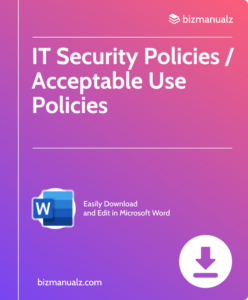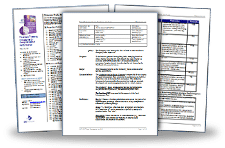What Guidance Identifies Federal Information Security Controls?

Cracking the code of federal information security controls can be tough! To get the hang of this tricky landscape, it’s essential to understand the guidance that identifies these controls for your security plan. This article will help by shedding light on the various resources available. What guidance identifies federal information security controls?
Understanding Guidance for Federal Information Security Controls
| Control Family | Security Control Description | Examples Security Control |
|---|---|---|
| Access Control | Limits access to authorized individuals or systems | User authentication, Role-based access control |
| Audit and Accountability | Ensures accountability & tracks system activity | Logging system events, Regular auditing processes, Annual security reviews |
| Configuration Management | Maintains proper configuration of information systems | System hardening guidelines, Patch management procedures |
| Identification & Authentication | Verifies entities’ identities before granting system access | Password-based authentication, Biometric verification methods |
| Incident Response | Establishes procedures for detecting, responding to & mitigating security incidents | Incident reporting process, Incident response plan |
| Security Assessment & Authorization | Assesses system vulnerabilities & determines if they meet compliance requirements | Security assessment methodologies (e.g., vulnerability scans), Risk assessment framework (e.g., NIST), Identification of security risks |
To bolster cybersecurity, organizations must implement these suggestions:
- Update security policies & procedures regularly as per industry best practices.
- Form an incident response team of trained personnel.
- Review access privileges regularly.
- Periodically conduct risk assessments.
By following these steps, organizations can create a robust framework for federal information security controls. Cybersecurity is an ongoing process that requires continuous monitoring, adaptation & improvement to remain ahead of threats.
Frameworks and Regulations for Identifying Federal Information Security Controls
When selecting federal info security controls, various rules and regulations are incredibly significant. These provide structures for organizations to create and keep up with secure measures. Let us discover some of the widely used risk management frameworks and regulations:
| Framework/Regulation | Description |
|---|---|
| NIST SP 800-53 | The National Institute of Standards and Technology (NIST) provides a set of security controls for federal information systems. It covers areas such as access control, incident response, and risk management. |
| Federal Information Security Management Act (FISMA) | FISMA demands federal agencies to set up, apply and document minimum security standards for their information systems. Meeting FISMA ensures government agencies abide by the requirements for protecting sensitive data, which was enacted in the United States as part of the E-Government Act of 2002. Note: Organizations that must comply with FISMA includes: those contracting with federal agencies or that support a federal program or receive grants from federal agencies. |
| Cybersecurity Framework | Developed by NIST, the Cybersecurity Framework provides a risk-based approach to help organizations assess and improve their cybersecurity. It gives a common language for stakeholders to interact and work together. |
| Defense Federal Acquisition Regulation Supplement (DFARS) | DFARS puts forth cybersecurity requirements on defense contractors who handle or process controlled unclassified information (CUI). Contractors must implement specific security controls to guard CUI from unauthorized access. |
It’s important to notice that each risk management framework or regulation has its own scope and objectives. While some concentrate on general info security principles, others focus on certain industries or government sectors.
Pro Tip: When picking the best framework or regulation for your organization’s needs, it is essential to contemplate factors such as industry compliance requirements, organizational goals, and risk appetite. Doing in-depth research and seeking expert advice can support successful application of information security controls. Don’t fret, these federal info security documents here to safeguard your data, not take your heart.
Key Federal Information Security Guidance Documents
The federal government has supplied helpful guidance docs to help with info security. These are great resources for orgs that want to boost their cyber posture and implement baseline security controls.
One is the National Institute of Standards and Technology (NIST) Special Publication (SP) 800-53. It outlines a range of security controls and guidelines for federal agencies to follow. Access control, incident response, risk assessment, system integrity – it covers all these areas. By following these guidelines, organizations can guarantee the security of their information assets.
The Federal Information Security Modernization Act (FISMA) is another key source of guidance. Passed in 2002, it requires federal agencies to implement robust security programs. This includes continuous monitoring, risk management, and compliance with standards. The Office of Management and Budget (OMB) supervises agencies’ FISMA compliance.
Additionally, the Committee on National Security Systems Instruction (CNSSI) No. 1253 helps pick and use appropriate security controls for national security systems. This instruction is specifically tailored to protecting classified or sensitive information.
Pro Tip: To get a full understanding of federal information security controls, look to authoritative guidance such as NIST SP 800-53, FISMA regulations, and CNSSI No. 1253.
Here’s a look at key federal government info security guidance and why it’s important:
| Guidance Document | Description |
|---|---|
| NIST Special Publication 800-53 | Gives comprehensive security controls and instructions for federal info systems. |
| Federal Information Security Modernization Act (FISMA) Implementation Project | Offers support for implementing FISMA needs, including risk management and constant monitoring. |
| NIST Cybersecurity Framework | Has a system for orgs to control and cut cyber risks through processes like identification, protection, noticing, answering, and recovering. |
| National Strategy to Secure Cyberspace | Displays a tactical approach to securing cyberspace, with a focus on public-private partnerships. |
| Federal Risk and Authorization Management Program (FedRAMP) | Establishes a standardized approach to reviewing the security of cloud services used by federal agencies. |
To keep improving info security, orgs can take these steps:
- Regular Training: Give staff regular lessons to show them the importance of info security and teach them the skills they need.
- Incident Response Planning: Make a plan that explains what to do in the event of a cyber incident, guaranteeing fast and effective action.
- Vulnerability Assessments: Do regular vulnerability assessments to recognize weaknesses in systems and networks, so proactive measures can be taken.
- Strong Authentication Mechanisms: Use multi-factor authentication methods like biometrics or token-based systems to upgrade user authentication procedures.
- Encryption Usage: Utilize encryption techniques to secure sensitive data both when stored and sent, decreasing the possibility of unauthorized access.
By doing these things, orgs can strengthen their overall cyber posture and protect their crucial info assets from potential risks. Implemented and Assessed Federal Info Security Controls – because making our gov’s data more secure than a double-locked vault is no joke.
Implementing and Assessing Federal Information Security Controls
-
- Identify the info assets needing protection – Step 1.
- Choose security controls based on org requirements – Step 2.
- Integrate controls into existing systems – Step 3.
- Monitor and assess effectiveness of implemented controls – Step 4.
- Maintain and update security controls to adapt to threats and tech – Step 5.
Don’t forget to ensure compliance with relevant regulations and standards, such as NIST SP guidelines. FISMA mandated federal agencies to develop and maintain comprehensive security programs to protect their info system security in 2002. Identifying federal info security controls is like playing hide and seek – but instead of finding a hidden friend, uncover a labyrinth of cyber threats.
Challenges and Best Practices in Identifying Federal Information Security Controls
Identifying federal info security controls has its own share of complications, as well as practices to manage these issues. It’s essential for organizations to identify the cybersecurity skills needed to handle these difficulties and put the best practices in place to ensure strong info security.
Let’s take a look at what the challenges and best practices are in this area, with an accompanying table:
| Challenge | Best Practice |
|---|---|
| Lack of awareness and understanding | Regular training sessions for staff |
| Evolving threat landscape | Stay up-to-date with latest security trends and tech |
| Compliance with regulatory requirements | Regularly monitor and assess compliance |
| Limited resources | Prioritize risks and allocate resources effectively |
We’ve discussed some key challenges and best practices, but there’s more to consider. Organizations should create guidelines for reporting potential security issues quickly. Additionally, they should build strong ties with external entities to identify threats proactively.
As for tips, organizations should invest in advanced monitoring tools to detect cyber threats. Automating the identification process saves time and increases accuracy. Regular security audits can provide useful information into possible vulnerabilities that were missed. In the end, info security controls and security policies that are not maintained are pretty ineffective.
Federal Information Security Controls
It’s key to abide by the directions on federal information security controls for keeping sensitive data safe. This way, organizations can set up strong cyber security. In short, recognizing and using federal government info security controls is a must to preserve the confidentiality, availability, and strength of important data. Organizations must stick to these controls to reduce risks and protect against cyber threats. Failing to do this could lead to dire outcomes like data leaks, financial losses, and a damaged reputation.
Frequently Asked Questions
1. What is the guidance that identifies federal information security controls?
The guidance that identifies federal information security controls is the National Institute of Standards and Technology (NIST) Special Publication 800-53.
2. Who is responsible for implementing the federal information security controls?
The head of each federal agency is responsible for implementing the federal information security controls within their agency.
3. What are the objectives of federal information security controls?
The objectives of federal information security controls are to ensure the confidentiality, integrity, and availability of federal information and information systems.
4. Why is it important to implement federal information security controls?
Implementing federal information security controls helps to prevent unauthorized access, protect sensitive information, and ensure compliance with federal regulations.
5. What are the different types of federal information security controls?
The different types of federal information security controls include administrative, physical, and technical controls.
6. How can I learn more about federal information security controls?
You can learn more about federal information security controls by visiting the NIST website or contacting your agency’s information security officer.


















Leave a Reply